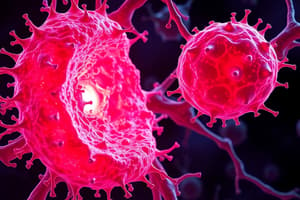Podcast
Questions and Answers
What is the characteristic of carcinoma in situ?
What is the characteristic of carcinoma in situ?
- It is a form of cancer that metastasizes rapidly.
- It invades surrounding tissues and stroma.
- It spreads to the lymphatic system.
- It affects only epithelial cells without invasion. (correct)
What does the term 'translocation' refer to in relation to cancer cells?
What does the term 'translocation' refer to in relation to cancer cells?
- The addition of a chromosome segment to another chromosome. (correct)
- The migration of cancer cells from one organ to another.
- The stages of cancer development over time.
- The process of cancer cell differentiation.
What role do hallmark characteristics play in cancer cells?
What role do hallmark characteristics play in cancer cells?
- They indicate early detection methods.
- They signify predictable cancer treatment responses.
- They give cancer cells advantages over normal cells. (correct)
- They represent benign growth features.
Which type of cancer primarily arises from epithelial cells?
Which type of cancer primarily arises from epithelial cells?
How is carcinoma in situ defined?
How is carcinoma in situ defined?
What characterizes benign tumors?
What characterizes benign tumors?
Which statement best defines anaplasia?
Which statement best defines anaplasia?
What can trigger mutations that lead to cancer?
What can trigger mutations that lead to cancer?
How do malignant tumors differ from benign tumors?
How do malignant tumors differ from benign tumors?
In the context of cancer, what does the term 'detached from the rest' refer to?
In the context of cancer, what does the term 'detached from the rest' refer to?
Which type of tumor is characterized by abnormal cells that can invade other tissues?
Which type of tumor is characterized by abnormal cells that can invade other tissues?
What is a distinguishing feature of lipomas?
What is a distinguishing feature of lipomas?
What happens when a cell mutates in relation to cancer development?
What happens when a cell mutates in relation to cancer development?
Which statement best describes proto-oncogenes?
Which statement best describes proto-oncogenes?
What role do tumor suppressor genes play?
What role do tumor suppressor genes play?
What is the Warburg effect?
What is the Warburg effect?
What happens when genomic instability occurs?
What happens when genomic instability occurs?
Which of the following best describes the role of macrophages in cancer?
Which of the following best describes the role of macrophages in cancer?
During which cancer stage does local invasion begin?
During which cancer stage does local invasion begin?
How does chronic inflammation contribute to cancer?
How does chronic inflammation contribute to cancer?
What is the significance of telomeres in cancer cells?
What is the significance of telomeres in cancer cells?
Which statement is true regarding the immune system and cancer?
Which statement is true regarding the immune system and cancer?
What characterizes metastatic cancer?
What characterizes metastatic cancer?
What role do caretaker genes serve in genomic stability?
What role do caretaker genes serve in genomic stability?
Which symptom is commonly associated with cancer?
Which symptom is commonly associated with cancer?
What function does angiogenesis serve in cancer development?
What function does angiogenesis serve in cancer development?
Which of the following describes paraneoplastic syndromes?
Which of the following describes paraneoplastic syndromes?
Flashcards are hidden until you start studying
Study Notes
Biology of Cancer
- Cancer is characterized by uncontrolled cell division and the ability to invade surrounding tissues.
- There are two main types of tumors:
- Benign tumors are noncancerous and do not invade surrounding tissues.
- Malignant tumors are cancerous and can invade surrounding tissues.
- Anaplasia describes the loss of cellular differentiation, which often occurs in cancer cells.
- Proto-oncogenes are normal genes that, when mutated, can become oncogenes. Oncogenes promote uncontrolled cell proliferation.
- Tumor suppressor genes act as "brakes" on cell division, inhibiting proliferation and preventing mutations.
- Genomic instability, which is a characteristic of many cancers, refers to an increased rate of mutations.
- Replicative immortality means that cancer cells can divide indefinitely, whereas normal body cells have a limited lifespan.
- Telomeres, protective caps on chromosomes, get shorter with each cell division.
- Cancer cells can activate telomerase, an enzyme that maintains telomere length.
- Angiogenesis, the growth of new blood vessels, sustains tumor growth.
- Reprogramming energy metabolism is another hallmark of cancer cells, characterized by a shift towards aerobic glycolysis, also known as the Warburg effect.
- Apoptosis, programmed cell death, can be evaded in cancer cells, allowing them to survive and proliferate.
- Tumor-promoting inflammation can contribute to cancer development.
- Tumor-associated macrophages (TAMs) are immune cells that can promote tumor survival and suppress the immune response.
- Evading immune system is a crucial step in cancer progression.
- Immunotherapy aims to enhance the immune system's ability to target cancer cells.
- Activating invasion and metastasis is the process of cancer cells spreading to other parts of the body.
- Local invasion refers to the spread of cancer within the tissue.
- Metastasis occurs when cancer cells spread from the primary tumor to distant sites.
- Stages of cancer refer to the extent of the spread:
- Stage 1: Confined to the original site.
- Stage 2: Local invasion.
- Stage 3: Spread to regional structures, often through lymphatics.
- Stage 4: Distant metastasis, spread through the blood.
- Signs of cancer can include fatigue, pain, anorexia, cachexia, and paraneoplastic syndromes (symptoms not caused by the tumor itself, but by its effects on the body).
Studying That Suits You
Use AI to generate personalized quizzes and flashcards to suit your learning preferences.



